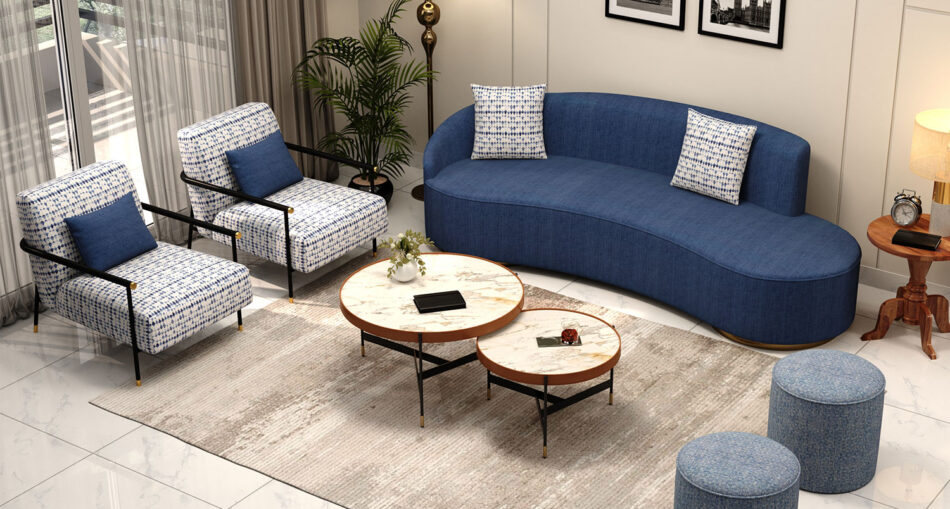A well-designed living room should feel open, welcoming, and airy, even if your home is compact. In urban homes and modern apartments, space is often limited, but with the right design choices, any living room can appear significantly larger than it is. From clever furniture placement to color selection and lighting strategies, creating the illusion of space is all about balance and smart styling.
Here are six expert-approved living room design tips that can instantly give your space a more expansive and elegant look.
1. Choose Light and Neutral Color Palettes
Color has the power to visually open up or shrink a space. Light and neutral tones such as soft whites, beiges, pale grays, and muted pastels help reflect more natural light, making the room feel brighter and more open. These colors create a seamless and calming backdrop that tricks the eye into perceiving more space.
If you prefer a bit of contrast, introduce darker accents through accessories like cushions, rugs, or a single statement chair—but ensure the base remains light to maintain the illusion of spaciousness. Walls painted in light hues paired with similar-toned ceilings and floors eliminate harsh breaks and visually expand the room’s dimensions.
2. Incorporate Multi-Functional and Low-Profile Furniture
Furniture can quickly make or break a small living room. To maximize space, opt for multi-functional pieces—think storage ottomans, extendable coffee tables, or sofas with hidden compartments. These pieces reduce clutter by offering extra utility without consuming additional floor space.
Low-profile furniture with sleek legs and open bases also makes a big difference. When furniture is raised off the floor, it allows light and sightlines to flow freely around the room, contributing to a more open and less bulky aesthetic. Avoid oversized or heavily upholstered items that dominate the layout.
3. Maximize Natural Light and Use Mirrors Strategically
A bright room always appears more spacious. To make the most of your natural light, keep window treatments sheer and minimal. Use light-filtering curtains, blinds, or even leave windows bare where privacy isn’t a concern. This not only enhances brightness but also connects your interior with the outside, extending the perceived boundaries of your living room.
Mirrors are another smart design tool. Positioning a large mirror across from a window reflects both light and scenery, doubling the visual space. Mirrors with elegant frames can also double as art pieces, adding function and flair at once.
4. Apply Vertical Design Ideas for Living Room Storage
When floor space is limited, look up. Vertical storage helps you make use of the full height of your living room without encroaching on valuable ground area. Consider tall bookshelves, wall-mounted cabinets, or floating shelves that draw the eye upward and create a sense of architectural height.
Using vertical space effectively is one of the most efficient living room design. Mount your TV on the wall instead of using a bulky console, hang artwork vertically, or install tall indoor plants in slim planters to add vertical lines and balance. These elements lift the eye and visually stretch the room.
5. Keep the Layout Open and Decluttered
An open and clutter-free layout is essential for making a room feel larger. Arrange furniture to create clear pathways and maintain openness in high-traffic zones. Avoid pushing all the furniture against the walls—floating a sofa with space behind it can sometimes make the room feel more dynamic and less boxed in.
Limit decorative items and avoid overcrowding surfaces. Choose a few impactful pieces—like a sculptural vase or a standout lamp—and space them apart to allow visual breathing room. Organize cables, remote controls, and small items using concealed storage baskets or trays.
6. Use Rugs and Lighting to Define Zones
In open-concept spaces or studio layouts, defining zones can help bring order without building physical partitions. Area rugs are excellent for anchoring furniture groups and adding structure. Choose rugs with subtle patterns or solid colors that harmonize with your palette.
Lighting plays a critical role in shaping the atmosphere. Layered lighting—using a combination of ceiling lights, floor lamps, and table lamps—adds depth and flexibility. Use lighting to highlight different zones or features, such as artwork, corners, or reading nooks. Avoid heavy pendant lights or bulky chandeliers in small rooms; instead, go for slim fixtures or recessed lighting.
Final Thoughts
Creating a spacious-looking living room doesn’t require a major renovation—it’s about making intentional, thoughtful choices. From using reflective surfaces and light colors to selecting slim, multi-functional furniture, these strategies can dramatically alter how your space feels.
By applying these smart design principles and integrating clever design ideas for living room expansion, you can achieve a living room that feels open, airy, and effortlessly inviting, regardless of its actual square footage.






